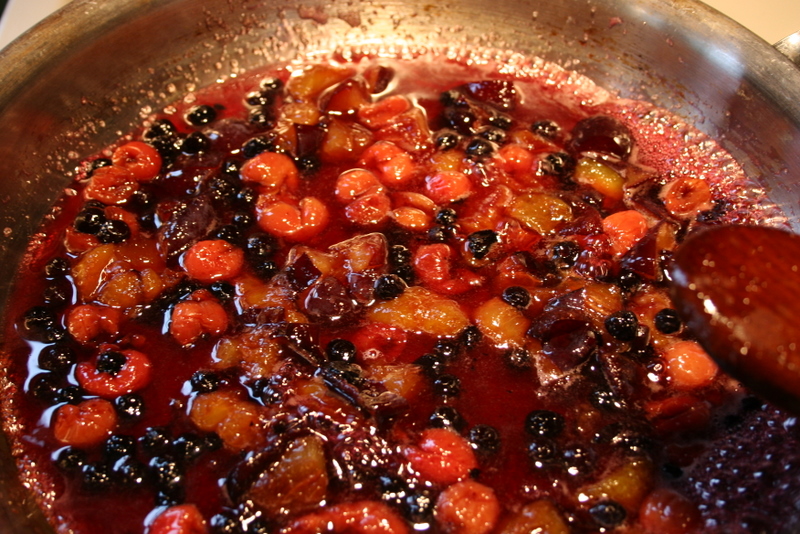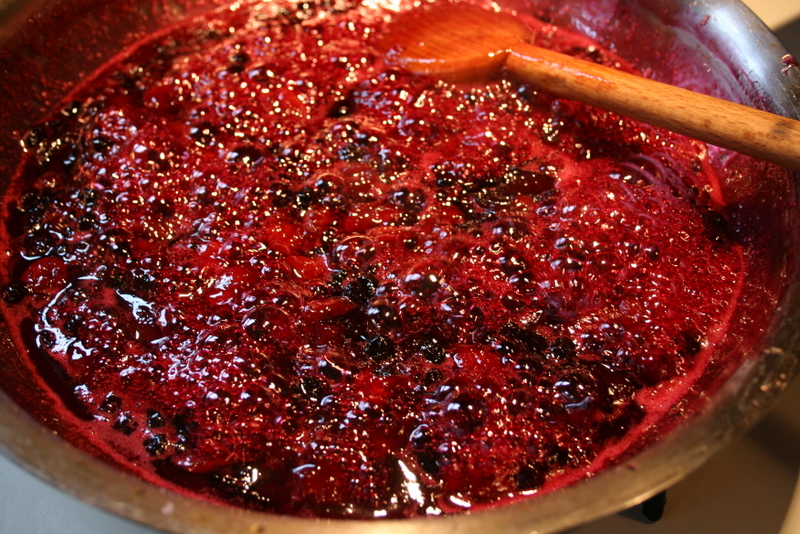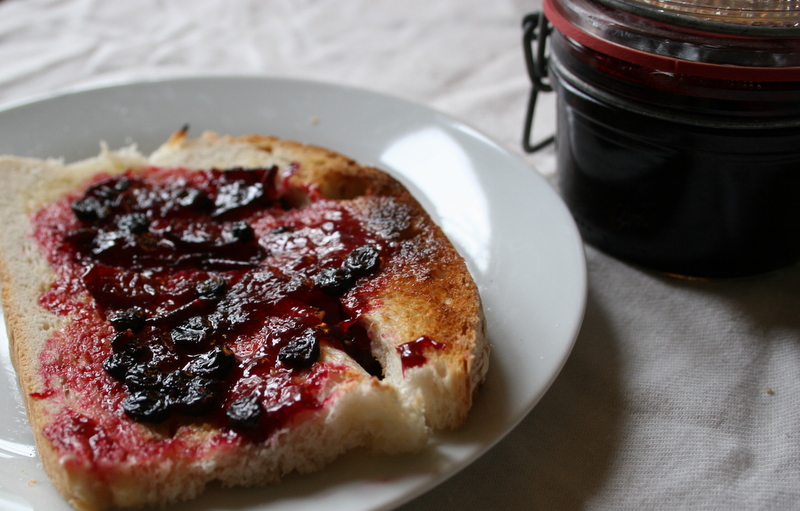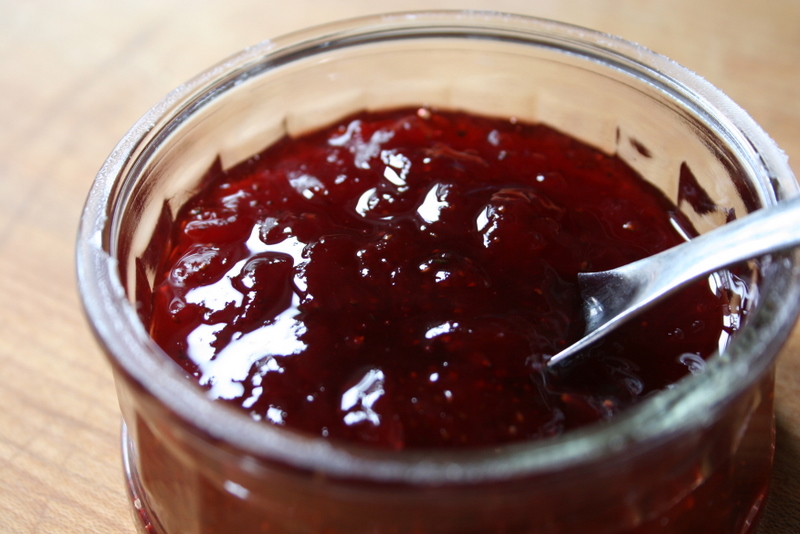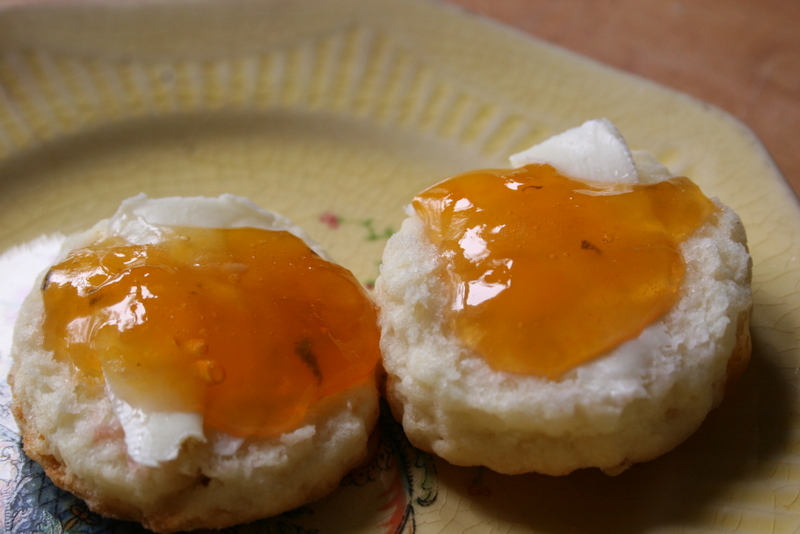Winter foraging is a fun way to enjoy this season and to make sure you get a bit of sunshine. We need vitamin D to keep the winter blues at bay.
Out of the frying pan, into the... jam jar?
A little while ago, I wrote about my new love of herbed fruit jams. Before that, I told you about the Japanese knotweed jelly I was enjoying. If you hadn't figured it out, I really love making jellies and jams. I've said before that preserves make me feel rich. All lined up in my pantry, they're like luminous jewels, ensuring that, no matter what goes wrong in this world, I have something tasty to spread on my toast.
There was a time when I didn't consider anything less than an 6-pint batch of jam to be worth my time. I wanted, for my efforts, to have at least a dozen 1/2-pint jars gleaming at me, their tops pinging shut amid the steam and the stickiness of my fruit-spattered kitchen. It was thrilling. I felt like an old-fashioned homesteader, a pioneer wife lovingly preserving the season's bounty for my adoring family.
But that was a simpler time, before my family grew to include two boys who, if left unattended for five minutes, will destroy one another or my home (or both). I just don't have the hours I once had to dedicate to the pitting of cherries or the peeling of apples. My preferred method of fruit preservation, these days, is cutting it up, winging it into bags, and stashing it in the deep freeze, then keeping my fingers crossed that we don't lose power for any length of time over the winter.
And yet, this family still needs jam. For toast, for sandwiches, for dropping spoonful-heavy into bowls of thick, white yogurt. So what do I do? I go to the freezer, bust out a few cups of frozen berries or some plum or peach halves, and then toss those into my trusty stainless steel skillet. This is one circumstance when I don't use my cast-iron pan: the iron can discolour the fruit, and the oil that seasons the pan can leave a weird slick on the finished jam. For one jar of jam, I use about a cup and a half to two cups of fruit, and somewhere between three-quarters of a cup and a cup and a half of sugar, depending on how tart the fruit is. If the fruit is in big pieces (like peaches or plums), I cut them up, or just leave them whole and take a potato masher to them as they cook down in the pan. I stir them together in the skillet, and cook them over rather high heat, stirring with a wooden spoon to make sure the fruit doesn't stick. When it's nicely simmering and the individual pieces of fruit are starting to break down (between 5 and 15 minutes, depending on the fruit), I squeeze in about a tablespoon of lemon juice (from a bottle). After another few minutes of simmering the jam should be thickening up nicely. I do the usual test to see if it's set up enough: I keep a bunch of spoons in the freezer, then test the jam by taking one frozen spoon, dropping some of the jam on it, then waiting a minute and seeing if it wrinkles when I stick my finger in it. Wrinkles mean it's ready. Then I scrape the whole thing into a clean jar, put a lid on it, and let it cool completely before putting it in the fridge.
There are some excellent advantages to making one jar of jam at a time. Because it's going straight into the fridge (and then onto my toast), I don't bother setting up the canner or sterilizing everything, any more than I would sterilize containers before packing away leftovers. Squeaky clean is good enough. The small amount is perfect for trying handfuls of fruit leftover from last year's freezer stash, or from the kids' snacks and lunches, or the one or two pieces of fruit looking a bit shriveled on the counter. If the combination works out, you can feel triumphant about having salvaged fruit that would otherwise have ended up in the compost, and if it doesn't work out (which really practically never happens), you can always bake it into a cake or muffins something, rather than having to suffer through a dozen jars of unpleasant preserves. If it doesn't thicken up, no big deal - pour it on ice cream or yogurt or pound cake, and try a new combination for the next jar.
When my kids are a little older, and I can shoo them away for long enough to do some massive batches of jam, I'll be right back into it, I'm sure. I still love those long lines of gleaming jars along the pantry shelf, and I love that sound of snap lids snapping away. But I won't let my lack of time stop me from making delicious jam whenever I have twenty minutes or so to spare. If you've been wary of preserving because it's so time consuming, maybe you just need to start slow - one jar at a time.
A new kind of jam
I managed to get over to my favourite u-pick here in St. John's last week. I picked and picked and picked and came home with far more strawberries than I could possibly eat. Which was just fine, because these berries were destined for the jam pot. My husband and daughter both love strawberry jam. I, on the other hand, am not entirely crazy about it. Since I had such a huge load of berries, I decided to make some plain jam (to please the family) and some fancy jam (to impress myself, since I'm not sure anyone else really cares all that much about my fancy jam... except you guys, right?). I thought to myself, "Self, what would jazz up this strawberry jam?" And myself answered, "Well, rosemary, obviously!"
Sounds crazy, I know, but a quick internet search revealed that I was not the first person to have thought of this. There were a couple recipes online, but they were both on the sketchy and unsafe side, with poor directions and totally obsolete canning methods. A note to you all: if a recipe ever suggests you use the "inversion method" of canning, run away. "Inversion" means "pour steaming hot jam into a jar, screw the lid on, and turn the jar upside down." Not only does this method create a warm, sticky space for bacteria to thrive, it also creates the risk of steam becoming trapped in the jar and near-boiling jam exploding all over you, sending shards of glass and scalding preserves everywhere.
But I digress. When I make jam, I don't use a recipe so much as a method. For every cup of fruit, I use between 3/4 cup and one full cup of sugar, as I learned to do in The Joy of Cooking. This pretty much guarantees a good jell, and it's enough sugar that I don't have to worry too much about the jam spoiling (provided I process it properly, as per the instructions on the Bernardin site). Any less and you're in the realm of "low-sugar canning," which requires specially prepared commercial pectin and about which I know nothing. If I needed to make a low-sugar jam, I would just play it safe and keep it in the freezer. I'm obsessive like that, because botulism sounds like an absolute horror show.
Anyway, back to my jam, which was a revelation. I cut up 8 cups of strawberries, and combined them with 6 cups of sugar in a great big pot. I let them sit like that for a few hours, while I did other things, and I occasionally gave them a stir to make sure the sick amount of sugar was dissolving. Then, when I had cleaned the kitchen adequately, I filled up my canner, sterilized my jars and lids, gathered my tools, and put my jam on to cook. I added 5 tablespoons of lemon juice to the berry-sugar mix, because strawberries don't have much pectin, and so they make a very runny jam unless you add something to firm them up. Grated green apple also works well.
I won't go into the details of cooking jam and knowing when it's ready, and what you do with it when it is, because the people at Bernardin have excellent directions for that (Marisa at Food in Jars is another excellent adviser). But I will tell you that, just as the jam was starting to jell, I added about 30 leaves of rosemary from the pot on my front step, which I had chopped very finely. And it changed everything. The depth of flavour! The tingly feel on the tongue! This really is an amazing discovery, this adding-herbs-to-jam thing, and I am now determined to make the most of it.
This morning, I decided to try another fruit-herb pairing: yellow plums and sage. Hell-o! The plums were super tart, so I used almost the same amount of sugar as I had fruit (2 cups sugar to 2 1/2 cups chopped plums, with no need for lemon juice as plums have loads of pectin), and right at the end I added three large fresh sage leaves, also finely chopped. This is even better than the strawberry-rosemary combo! I am on a roll!
As the summer goes on, I plan to try blackberries with lemon balm, and I have heard that blueberries and basil are an awesome flavour fusion. I also have a lavender plant in the yard that I would like to combine with fruit to make jammy goodness. Any suggestions? Have you combined fruit and herbs before?








